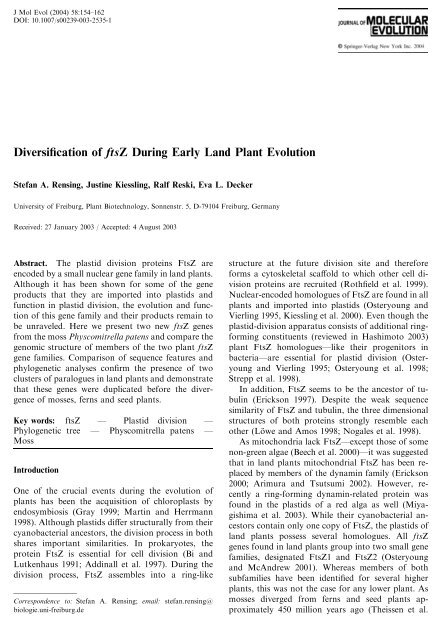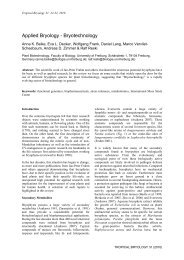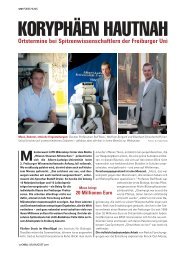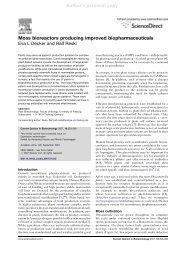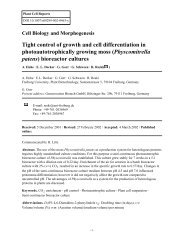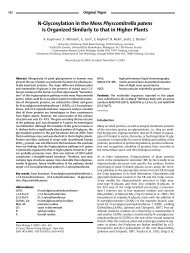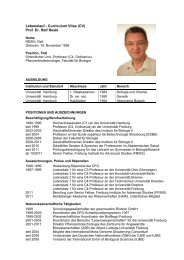Diversification of ftsZ During Early Land Plant Evolution
Diversification of ftsZ During Early Land Plant Evolution
Diversification of ftsZ During Early Land Plant Evolution
You also want an ePaper? Increase the reach of your titles
YUMPU automatically turns print PDFs into web optimized ePapers that Google loves.
J Mol Evol (2004) 58:154–162<br />
DOI: 10.1007/s00239-003-2535-1<br />
<strong>Diversification</strong> <strong>of</strong> <strong>ftsZ</strong> <strong>During</strong> <strong>Early</strong> <strong>Land</strong> <strong>Plant</strong> <strong>Evolution</strong><br />
Stefan A. Rensing, Justine Kiessling, Ralf Reski, Eva L. Decker<br />
University <strong>of</strong> Freiburg, <strong>Plant</strong> Biotechnology, Sonnenstr. 5, D-79104Freiburg, Germany<br />
Received: 27 January 2003 / Accepted: 4August 2003<br />
Abstract. The plastid division proteins FtsZ are<br />
encoded by a small nuclear gene family in land plants.<br />
Although it has been shown for some <strong>of</strong> the gene<br />
products that they are imported into plastids and<br />
function in plastid division, the evolution and function<br />
<strong>of</strong> this gene family and their products remain to<br />
be unraveled. Here we present two new <strong>ftsZ</strong> genes<br />
from the moss Physcomitrella patens and compare the<br />
genomic structure <strong>of</strong> members <strong>of</strong> the two plant <strong>ftsZ</strong><br />
gene families. Comparison <strong>of</strong> sequence features and<br />
phylogenetic analyses confirm the presence <strong>of</strong> two<br />
clusters <strong>of</strong> paralogues in land plants and demonstrate<br />
that these genes were duplicated before the divergence<br />
<strong>of</strong> mosses, ferns and seed plants.<br />
Key words: <strong>ftsZ</strong> — Plastid division —<br />
Phylogenetic tree — Physcomitrella patens —<br />
Moss<br />
Introduction<br />
One <strong>of</strong> the crucial events during the evolution <strong>of</strong><br />
plants has been the acquisition <strong>of</strong> chloroplasts by<br />
endosymbiosis (Gray 1999; Martin and Herrmann<br />
1998). Although plastids differ structurally from their<br />
cyanobacterial ancestors, the division process in both<br />
shares important similarities. In prokaryotes, the<br />
protein FtsZ is essential for cell division (Bi and<br />
Lutkenhaus 1991; Addinall et al. 1997). <strong>During</strong> the<br />
division process, FtsZ assembles into a ring-like<br />
Correspondence to: Stefan A. Rensing; email: stefan.rensing@<br />
biologie.uni-freiburg.de<br />
structure at the future division site and therefore<br />
forms a cytoskeletal scaffold to which other cell division<br />
proteins are recruited (Rothfield et al. 1999).<br />
Nuclear-encoded homologues <strong>of</strong> FtsZ are found in all<br />
plants and imported into plastids (Osteryoung and<br />
Vierling 1995, Kiessling et al. 2000). Even though the<br />
plastid-division apparatus consists <strong>of</strong> additional ringforming<br />
constituents (reviewed in Hashimoto 2003)<br />
plant FtsZ homologues—like their progenitors in<br />
bacteria—are essential for plastid division (Osteryoung<br />
and Vierling 1995; Osteryoung et al. 1998;<br />
Strepp et al. 1998).<br />
In addition, FtsZ seems to be the ancestor <strong>of</strong> tubulin<br />
(Erickson 1997). Despite the weak sequence<br />
similarity <strong>of</strong> FtsZ and tubulin, the three dimensional<br />
structures <strong>of</strong> both proteins strongly resemble each<br />
other (Lo¨ we and Amos 1998; Nogales et al. 1998).<br />
As mitochondria lack FtsZ—except those <strong>of</strong> some<br />
non-green algae (Beech et al. 2000)—it was suggested<br />
that in land plants mitochondrial FtsZ has been replaced<br />
by members <strong>of</strong> the dynamin family (Erickson<br />
2000; Arimura and Tsutsumi 2002). However, recently<br />
a ring-forming dynamin-related protein was<br />
found in the plastids <strong>of</strong> a red alga as well (Miyagishima<br />
et al. 2003). While their cyanobacterial ancestors<br />
contain only one copy <strong>of</strong> FtsZ, the plastids <strong>of</strong><br />
land plants possess several homologues. All <strong>ftsZ</strong><br />
genes found in land plants group into two small gene<br />
families, designated FtsZ1 and FtsZ2 (Osteryoung<br />
and McAndrew 2001). Whereas members <strong>of</strong> both<br />
subfamilies have been identified for several higher<br />
plants, this was not the case for any lower plant. As<br />
mosses diverged from ferns and seed plants approximately<br />
450 million years ago (Theissen et al.
155<br />
Fig. 1. Exon–intron structure <strong>of</strong> Physcomitrella and Arabidopsis <strong>ftsZ</strong> genes. Exons are shown as rectangular boxes: introns, as triangles. The exon containing the GTPase/tubulin motif is shown in<br />
pink. Introns that are assumed to be homologous are presented in the same color throughout the sequences.
156<br />
2001), we wanted to include as many as possible moss<br />
sequences into the phylogenetic analysis to clarify<br />
when during land plant evolution the separation into<br />
two gene families took place.<br />
We searched a clustered Physcomitrella EST database<br />
(Rensing et al., 2002) for <strong>ftsZ</strong> homologues and<br />
subsequently cloned and sequenced the genes <strong>of</strong> two<br />
new Physcomitrella patens <strong>ftsZ</strong> family members to<br />
enable a better understanding <strong>of</strong> the evolution <strong>of</strong><br />
these plant gene families.<br />
Materials and Methods<br />
Cloning and Sequencing<br />
Two new Physcomitrella patens <strong>ftsZ</strong> genes are being presented in this<br />
study, <strong>ftsZ</strong> 1-1 (AJ428993) and 1-2 (AJ428994). From a clustered<br />
EST database covering nearly the whole transcriptome (Rensing et<br />
al. 2002), clusters defining the previously unknown sequences were<br />
revealed by homology searching with members <strong>of</strong> the plant FtsZ1<br />
family. Subsequent cloning and sequencing as well as RACE-PCR<br />
using the RLM-RACE Kit (Ambion, Germany) yielded the fulllength<br />
cDNA sequences. To analyze the genomic structure <strong>of</strong> the<br />
genes, different sets <strong>of</strong> primers were synthesized. Genomic DNA was<br />
extracted as described previously (Reski et al. 1994) and used as<br />
template for PCR amplification. The resulting PCR products were<br />
subcloned in pCR 4-Topo (Invitrogen, Germany) and both strands<br />
sequenced with appropriate overlaps by primer walking.<br />
S<strong>of</strong>tware<br />
The GCG Wisconsin package 10.2 (Accelrys, USA) was used for<br />
sequence analysis as well as CLUSTAL W 1.81 (Thompson et al.<br />
1994) for multiple sequence alignment. Homology searches were<br />
conducted with BLAST 2 (Altschul et al. 1997). Phylogenetic trees<br />
were created with TREECON 1.3b (Van de Peer and De Wachter<br />
1994) and TREE-PUZZLE 5.1 (Schmidt et al. 2002). Peptide distances<br />
were calculated from the alignment using the GCG s<strong>of</strong>tware<br />
Distances with Kimura parameters.<br />
The GENPEPT database (release 124.0; www.ncbi.nlm.nih.<br />
gov), being a conceptual translation <strong>of</strong> GenBank, was used as a<br />
peptide database covering the known protein coding genes from all<br />
organisms. The FtsZ and tubulin motifs were extracted from<br />
PROSITE (release 16.37; www.expasy.ch).<br />
Database Searches<br />
BLASTP searches against GENPEPT as well as TBLASTN<br />
searches against the GENBANK EST_OTHER division (nonhuman/mouse)<br />
were run using full-length FtsZ peptide sequences<br />
known to belong to the plant FtsZ1 family (Pisum sativum) and<br />
FtsZ2 family (Gentiana lutea). From the significant hits a subset <strong>of</strong><br />
33 sequences was extracted for further analysis, covering all photosynthetic<br />
organisms (cyanobacteria, algae, and land plants).<br />
Redundant sequences were removed and some ESTs clustered<br />
(Table 1).<br />
Alignment and Tree Reconstruction<br />
The above-mentioned peptide sequences were subjected to a multiple<br />
sequence alignment using default parameters, leading to an<br />
alignment <strong>of</strong> 530 positions. Manual inspection <strong>of</strong> the alignment did<br />
not reveal any obvious errors, therefore it was not altered before<br />
further analyses took place. Neighbor-joining trees were done using<br />
the Tajima and Nei (1984) model; InDels were not taken into account.<br />
Maximum likelihood analysis was done using the Whelan<br />
and Goldman (2001) substitution model with data set frequencies,<br />
exact parameter estimation, and eight gamma distributed heterogeneity<br />
rates.<br />
Results and Discussion<br />
Isolation <strong>of</strong> Two New moss <strong>ftsZ</strong> Genes; Comparison<br />
with Arabidopsis<br />
We cloned and sequenced both the full-length cDNA<br />
and the genomic loci <strong>of</strong> two novel <strong>ftsZ</strong> genes. These<br />
new Physcomitrella <strong>ftsZ</strong> homologues group in the<br />
land plant FtsZ1 family (see below) and therefore<br />
are designated <strong>ftsZ</strong> 1-1 and <strong>ftsZ</strong> 1-2. The two previously<br />
published <strong>ftsZ</strong> homologues 1 and 2 (Kiessling<br />
et al. 2000) cluster in the land plant FtsZ2 clade<br />
and are therefore renamed <strong>ftsZ</strong> 2-1 and <strong>ftsZ</strong> 2-2,<br />
respectively.<br />
The genomic organization <strong>of</strong> the Physcomitrella<br />
and Arabidopsis <strong>ftsZ</strong> genes is shown in Fig. 1.<br />
Whereas the sequences <strong>of</strong> <strong>ftsZ</strong> 2-1 (‘‘1’’) and 2-2 (‘‘2’’)<br />
remarkably resemble each other (Kiessling et al.<br />
2000), <strong>ftsZ</strong> 1-1 and 1-2 show a different organization.<br />
The genes for 2-1 and 2-2 both contain six introns in<br />
conserved positions and differ mainly in the slightly<br />
different sized exon 1 and intron 6. FtsZ 1-1, on the<br />
other hand, contains five introns about evenly spaced<br />
among the sequence, whereas 1-2 is host to just three<br />
introns that resemble the positions <strong>of</strong> introns 2, 3,<br />
and 4<strong>of</strong> 1-1 or introns 1, 2, and 3 <strong>of</strong> 2-1/2-2. The<br />
close relationship <strong>of</strong> <strong>ftsZ</strong> 2-1 and 2-2 makes it probable<br />
that these genes were duplicated only recently, in<br />
terms <strong>of</strong> evolutionary history. Whether or not 1-1<br />
and 1-2 share a recent common ancestor, i.e., evolved<br />
by duplication <strong>of</strong> the gene and subsequent insertion<br />
or deletion <strong>of</strong> introns, cannot be answered yet.<br />
Although FtsZ 2-1 and 2-2 predictably have a low<br />
evolutionary distance (17.78 substitutions per 100<br />
positions), they share with 1-1 (86.95/86.98) and 1-2<br />
(93.63/94.81) about the same distance as the latter<br />
two among each other (92.36).<br />
In comparison with the Arabidopsis genes it becomes<br />
evident that Arabidopsis <strong>ftsZ</strong> 2-1 and 2-2 have<br />
a genomic structure resembling that <strong>of</strong> Physcomitrella<br />
<strong>ftsZ</strong> 2-1 and 2-2, whereas Arabidopsis <strong>ftsZ</strong> 1-1 is remarkably<br />
similar to Physcomitrella <strong>ftsZ</strong> 1-1.<br />
Figure 1 also displays a structural feature <strong>of</strong> the<br />
FtsZ proteins: the tubulin/GTPase motif-containing<br />
exon (pink). Because <strong>of</strong> the fundamental importance<br />
<strong>of</strong> this motif for FtsZ function, we assume that<br />
the exon harboring the tubulin/GTPase motif is<br />
homologous throughout the genes, as is also the case<br />
for the two introns bordering this exon. There are in
157<br />
Table 1.<br />
Sequences used for analyses<br />
Organism Nomenclature Family Acc. No. a EST Identical to/cluster with<br />
Arabidopsis thaliana 1-1 1 AAA82068 BAB08597, cDNA:U39877, gen.: AB010071<br />
Ceratopteris richardii 1 BE643351 X<br />
Medicacgo truncatula 1 AW775962 X<br />
Neottopteris nidus 1 AF275720 X<br />
Nicotiana tabacum 1-1 1 CAB89286<br />
Nicotiana tabacum 1-2 1 AAF23770<br />
Nicotiana tabacum 1-3 1 CABS9287<br />
Nicotiana tabacum 1-41 CAB41987<br />
Oryza sativa 1 AAK64282<br />
Physcomitrella patens 1-1 1 AJ428993<br />
Physcomitrella patens 1-2 1 AJ428994<br />
Pisum sativum 1 CAA75603<br />
Sorghum propinquum 1 BF588200 X<br />
Tagetes erecta 1 AAF81220<br />
Triticum aestivum 1 BE444075 X BE498211<br />
Arabidopsis thaliana 2-1 2 AAK92779 AAC35987, BAB68127, AAD21440,<br />
cDNA: AB052757, gen.: AC006921<br />
Arabidopsis thaliana 2-2 2 AAL07180 CAB89236, AAK63846, cDNA: AF384167,<br />
gen.: AL353912<br />
Chlamydomonas reinhardtii 2 BE441845 X BG855721, AV624700<br />
Gentiana lutea 2 AAF23771<br />
Lilium longiflorum 2 BAA96782<br />
Nicotiana tabacum 2-1 2 CAB89288<br />
Nicotiana tabacum 2-2 2 CAC44257<br />
Physcomitrella patens 2-1 (‘‘1’’) 2 CAB54558<br />
Physcomitrella patens 2-2 (‘‘2’’) 2 CAB76387<br />
Anabaena sp. cy-ng AAA85526<br />
Cyanidium caldarium 1 cy-ng BAA82871<br />
Cyanidium caldarium 2 cy-ng BAA82090<br />
Cyanidioschyzon merolae cy-ng BAA85116<br />
Guillardia theta cy-ng CAA07676 CAB40398<br />
Mallomonas splendens cy-ng AAF35433<br />
Nostoc sp. PCC 7120 cy-ng CAA83241<br />
Synechococcus sp. PCC 7942 cy-ng AAC26227<br />
Synechocystis sp. PCC 6803 cy-ng BAA17496<br />
a The accession numbers are GENPEPT except for the ESTs (EST_OTHER) and those mentioned as cDNA/genomic (GenBank). In the<br />
case <strong>of</strong> Chlamydomonas reinhardtii and Triticum aestivum, three and two EST sequences, respectively, have been used to build longer ORFs.<br />
total three introns shared by all the genes, the<br />
two above-mentioned ones (marked light and<br />
dark yellow) as well as another intron 3 0 <strong>of</strong> those<br />
(marked in red). Whereas the FtsZ2 family contains<br />
an additional intron in the extreme 3 0 end (blue;<br />
lacking from Arabidopsis <strong>ftsZ</strong> 2-1) and between the<br />
dark-yellow and the red introns (orange), the<br />
FtsZ1 family exhibits an additional intron in the<br />
5 0 end <strong>of</strong> the gene (green; lacking from Phycomitrella<br />
1-2). The intron shown in purple is common to<br />
both families as well but absent in Physcomitrella<br />
<strong>ftsZ</strong> 1-2.<br />
In terms <strong>of</strong> genomic organization, Physcomitrella<br />
<strong>ftsZ</strong> 2-1 and 2-2 and Arabidopsis <strong>ftsZ</strong> 2-2 strongly<br />
resemble each other. The same is the case for the<br />
Physcomitrella <strong>ftsZ</strong> 1-1 and the Arabidopsis <strong>ftsZ</strong> 1-1<br />
genes. The Arabidopsis <strong>ftsZ</strong> 2-1 gene, however, lacks<br />
one <strong>of</strong> the family 2 introns. The Physcomitrella <strong>ftsZ</strong><br />
1-2 gene lacks two <strong>of</strong> the family 1 introns and<br />
therefore seems to be quite atypical for its subfamily.<br />
FtsZ Peptide Sequence Features and Patterns<br />
A schematic representation <strong>of</strong> the FtsZ peptide<br />
sequence alignment is given in Fig. 2a. It depicts the<br />
location <strong>of</strong> the PROSITE FtsZ motifs 1 and 2 as well as<br />
the C-terminal core domain (Ma and Margolin 1999)<br />
and the highly conserved central region <strong>of</strong> the protein.<br />
Both the land plant FtsZ1 and 2 families (according to<br />
Osteryoung and McAndrew [2001]; see Table 1 for<br />
family assignment) and the nongreen organisms<br />
(cyanobacteria and nongreen algae) are shown as independent<br />
groups. A detailed description <strong>of</strong> the features<br />
present in plant FtsZ sequences is given by<br />
Osteryoung and McAndrew (2001). Here we want to<br />
emphasize the differences existing within the three<br />
subfamilies, plant FtsZ1 and FtsZ2 and cyanobacteria/<br />
nongreen algae (cy-ng). The existing PROSITE<br />
pattern PS01134is able to find FtsZ proteins from<br />
SWISS-PROT with a high accuracy (no false positives,<br />
low number <strong>of</strong> false negatives). However, the pattern
158<br />
Fig. 2. Schematic representation <strong>of</strong> FtsZ subfamilies and patterns, based on an alignment (580 aa) <strong>of</strong> chlorobiont FtsZ proteins, a The location <strong>of</strong> the two FtsZ PROSITE motives is shown, as well as<br />
the C-terminal core domain and the highly conserved region <strong>of</strong> the protein together with b the new motives. c Presence or absence <strong>of</strong> the C-terminal core domain including mismatches. See text for<br />
details.
159<br />
fails to detect a number <strong>of</strong> plant FtsZ1/2 family members<br />
from GENPEPT (data not shown). The PROSITE<br />
pattern PS01135 covers the FtsZ GTP-binding domain<br />
that includes the tubulin pattern PS00227 and can detect<br />
FtsZ family members in SWISS-PROT with about<br />
the same accuracy as the above-mentioned pattern. It<br />
fails, however, in detecting a number <strong>of</strong> both FtsZ2 and<br />
cy-ng family members because <strong>of</strong> a mismatch (data not<br />
shown). As the region covered by PS01134allows us to<br />
distinguish between the subfamilies FtsZ1/2 and cy-ng,<br />
we created patterns that enable this task. The pattern<br />
ftsz1-pl, (A,V)(I,V)NTDxQALxx(F,S)x(A,V)x{21,<br />
21} (L,T)GE(Q,E), is able to find all current FtsZ1<br />
family members in GENPEPT (without false positives/<br />
negatives), as is the case for the pattern called ftsz2-pl,<br />
I(V,A)NTD(I,V,A)QA(M,I,L)(R,K,A)xSPVx{23,23}<br />
IG(M,C,A)(N,S,K) for FtsZ2 and (I,V,L)NTD<br />
(A,S,V)QALxxxx(A,T)x{17,17}G(N,K)P(A,E)(I,V)<br />
Gx(K,Q) for cy-ng; the position <strong>of</strong> these new patterns<br />
is shown in Fig. 2b. The patterns will allow us<br />
to scan for new FtsZ sequences belonging to those<br />
groups in further releases <strong>of</strong> the international databases.<br />
Of course they might have to be subject to<br />
refinement as more sequence information becomes<br />
available.<br />
Phylogenetic Trees<br />
From the intron/exon structure <strong>of</strong> the four Physcomitrella<br />
<strong>ftsZ</strong> genes and from the phylogenetic trees<br />
is evident that an ancestral <strong>ftsZ</strong> gene was duplicated<br />
during the evolution <strong>of</strong> photosynthetic organisms.<br />
The phylogenetic tree including all photosynthetic<br />
organisms (Fig. 3) shows a clear separation <strong>of</strong> the<br />
chlorobiont (i.e., chlorophyll a/b-bearing organisms)<br />
FtsZ families 1 and 2, designated after the nomenclature<br />
for the Arabidopsis FtsZ proteins (see e.g.,<br />
Osteryoung and McAndrew 2001; Beech et al. 2000<br />
for other phylogenetic trees).<br />
The sequences from the cyanobacteria and<br />
nongreen algae both form strongly-supported monophyletic<br />
clades that cluster between the FtsZ1 and<br />
the FtsZ2 families. The cy-ng cluster appears to be<br />
more closely related to the FtsZ2 family, which also is<br />
the case in maximum likelihood analyses <strong>of</strong> this data<br />
set (not shown). Because cyanobacteria and nongreen<br />
algae, which appear generally to possess just one<br />
‘‘plastid’’-type FtsZ, cluster with the chlorobiont<br />
FtsZ2 family, it seems likely that the ‘‘original’’<br />
(ancestral) gene was the one that evolved to become<br />
this subfamily. The duplication giving rise to the<br />
FtsZ1 family must have taken place somewhere in the<br />
evolution <strong>of</strong> the green lineage, probably in the green<br />
algae before they occupied the land. Maximum likelihood<br />
analysis <strong>of</strong> the same data set (data not shown)<br />
confirms the overall topology <strong>of</strong> the neighbor-joining<br />
tree, while introducing some multifurcating branch<br />
points instead <strong>of</strong> bifurcation.<br />
Whereas the Physcomitrella FtsZ 2-1 and 2-2<br />
sequences cluster within the FtsZ2 family, FtsZ 1-1<br />
and 1-2 are found within the FtsZ1 family, albeit the<br />
latter sequence as a long-branch outgroup to the clade.<br />
The long branch <strong>of</strong> the 1-2 sequence might point to a<br />
pseudogene, however, transcription <strong>of</strong> the gene has<br />
been shown using RT-PCR (data not shown).<br />
As can be seen from the sequences <strong>of</strong> Arabidopsis,<br />
Physcomitrella, and tobacco, the typical plant genome<br />
seems to possess a small <strong>ftsZ</strong> gene family with<br />
at least one member to both the FtsZ1 and 2 subfamilies.<br />
This hypothesis is supported by our new<br />
Physcomitrella FtsZ sequences. Although there is no<br />
single fern or monocot plant present in the tree <strong>of</strong><br />
which two FtsZ sequences are available, this hypothesis<br />
seems to be a valid assumption for all land<br />
plants and probably even green algae, given the fact<br />
that there are monocot sequences in both subfamilies<br />
and sequences from the moss Physcomitrella—<br />
representing the oldest living branch <strong>of</strong> land plant<br />
evolution—show up in both clades as well.<br />
The tree is shown as unrooted. However, a phylogenetic<br />
analysis using additional sequences from<br />
eubacteria, mitochondria and Archaea (used as an<br />
outgroup root, shown as an asterisk [*] below) significantly<br />
placed the root at the branch separating the<br />
FtsZ2 clade from the FtsZ1/cy-ng clade in both<br />
neighbor-joining and maximum likeihood analyses<br />
(data not shown). In the maximum likelihood analysis<br />
<strong>of</strong> the above mentioned large data set, however,<br />
the three families were placed into a trifurcating<br />
branch point. In order to further investigate this, we<br />
calculated the likelihood <strong>of</strong> four different branching<br />
orders. Besides the determined trifurcating maximum<br />
likelihood topology [* ((cy, ng), <strong>ftsZ</strong>1, <strong>ftsZ</strong>2)] we<br />
tested the topology <strong>of</strong> the neighbour-joining tree [*<br />
<strong>ftsZ</strong>1, (<strong>ftsZ</strong>2, (cy, ng))] as well as an early branching<br />
<strong>of</strong> the whole cy-ng clade [* (cy, ng), (FtsZ1, FtsZ2)]<br />
and <strong>of</strong> the cyanobacteria alone [* cy, (ng, FtsZ1,<br />
FtsZ2)] (the latter making the most sense from an<br />
evolutionary point <strong>of</strong> view). All three topologies had<br />
a slightly worse ()10.63, )7.82 and )8.45) likelihood<br />
than the original tree and did not prove to be significantly<br />
worse in terms <strong>of</strong> the Kishino-Hasegawa<br />
(1989) test than the maximum likelihood tree.<br />
Therefore, detailed placement <strong>of</strong> the root was not<br />
possible.<br />
The peculiar predicted position <strong>of</strong> the FtsZ1 clade<br />
might be due to a long-branch phenomenon, as has<br />
been demonstrated in other cases as well (e.g. Figge<br />
et al. 1999). On the other hand, if the FtsZ2 family<br />
has evolved to exhibit a different function than FtsZ1<br />
(and the FtsZ <strong>of</strong> cyanobacteria and non-green algae)<br />
in the course <strong>of</strong> evolution, this might also explain<br />
the problems to resolve the correct branching order.
160<br />
Fig. 3. Neighbor-joining phylogenetic tree based on 530 amino acid positions. Numbers at the branches result from 1000 bootstrap<br />
resamplings. See text for details.<br />
Because <strong>of</strong> a change in function, it is to be expected<br />
that the region- or site-specific rate <strong>of</strong> acquired<br />
mutational differences will vary, potentially compromising<br />
the outcome <strong>of</strong> phylogenetic analyses.<br />
Interaction and Possible Function<br />
The fact that two divergent gene families with usually<br />
more than one member per family are present in<br />
plants suggests more than one function for FtsZ. The<br />
C terminus <strong>of</strong> bacterial FtsZ is described to interact<br />
with FtsA and ZipA (Ma and Margolin 1999; Yan et<br />
al. 2000; Haney et al. 2001). This short peptide pattern<br />
(Osteryoung and McAndrew 2001) can be found<br />
unambiguously in the extreme C terminus <strong>of</strong> most <strong>of</strong><br />
the FtsZ2 peptide sequences (Fig. 2c), in Physcomitrella<br />
2-1 and 2-2 it contains a mismatch. The pattern<br />
can also be found in most <strong>of</strong> the cy-ng family members,<br />
in some containing a single mismatch as well.<br />
The C termini <strong>of</strong> the Guillardia theta and Mallomonas<br />
splendens sequences do not contain this motif, as is<br />
the case for the FtsZ1 family with one noteworthy<br />
exception: Physcomitrella 1-2 does contain it with<br />
two mismatches. As the C-terminal domain is not<br />
tightly defined by a pattern, it remains speculative to<br />
conclude protein–protein interactions from the presence<br />
or absence <strong>of</strong> a short amino acid pattern.<br />
However, the nearly ubiquitous presence in the <strong>ftsZ</strong>2<br />
and cy-ng family members may suggest an interaction<br />
with other members <strong>of</strong> the plastid division machinery<br />
(e.g., putative ZipA/FtsA homologues or analogues).<br />
Import experiments performed in Physcomitrella<br />
and other organisms demonstrated that FtsZ proteins<br />
encoded by both gene families are subject to plastid<br />
localisation (Osteryoung and Vierling 1995; Gaikwad<br />
et al. 2000; Kiessling et al. 2000). The function <strong>of</strong> the<br />
gene products should be found mainly in plastids for<br />
this reason. On the other hand, when predicting<br />
cleavage sites <strong>of</strong> putative plastid transit signals, FtsZ1<br />
family members generally exhibit a much higher score<br />
than members <strong>of</strong> the FtsZ2 family (Osteryoung and<br />
McAndrew 2001), pointing to a possible difference in<br />
localization or import patterns.<br />
Although involvement in plastid division by means<br />
<strong>of</strong> a ring-like structure has been shown (Vitha et al.<br />
2001), additional functions seem possible, especially<br />
in the light <strong>of</strong> the obviously paralogous (compared<br />
with the cyanobacterial gene) FtsZ1 family. Members<br />
<strong>of</strong> the FtsZ1 family have quite a different genomic<br />
organization compared to the FtsZ2 group in terms<br />
<strong>of</strong> intron/exon structure and they also apparently do<br />
not contain the C-terminal core domain thought to<br />
be involved in interaction with proteins <strong>of</strong> the plastid<br />
division machinery.<br />
As the correct function <strong>of</strong> FtsZ1 in vivo may be<br />
dependent on tight control <strong>of</strong> stochiometry <strong>of</strong> the
161<br />
interaction partners—probably including interaction<br />
<strong>of</strong> <strong>ftsZ</strong> variants with each other—it seems quite likely<br />
that particular protein levels <strong>of</strong> both FtsZ families are<br />
needed for the precise action <strong>of</strong> FtsZ in land plants.<br />
New functions <strong>of</strong> plant FtsZ proteins have to be<br />
assumed (Reski, 2002) because <strong>of</strong> changing demands<br />
on the plastids during land plant evolution. In green<br />
algae, plastids are shaped into curious forms (the socalled<br />
chromatophores) quite <strong>of</strong>ten, i.e., they do not<br />
use the standard pattern <strong>of</strong> globular-shaped plastids.<br />
In both green algae and plants, plastids possess the<br />
ability to move, e.g., in dependence <strong>of</strong> light conditions.<br />
Whereas in single cellular algae the division <strong>of</strong><br />
the sole plastid is coordinated with the division <strong>of</strong> the<br />
cell, in the cells <strong>of</strong> multicellular green algae and<br />
plants, with their higher number <strong>of</strong> plastids per cell,<br />
cell cycle-independent plastid division and its coordination<br />
becomes a much more difficult process.<br />
Whereas in lower plants plastids are always green<br />
chloroplasts, in angiosperms proplastids have the<br />
capability to develop into specialized forms like<br />
chromoplasts, amyloplasts, or chloroplasts. Members<br />
<strong>of</strong> the two FtsZ families might be part <strong>of</strong> processes<br />
that yield those differences between lower and higher<br />
plants.<br />
Conclusions<br />
Our phylogenetic analyses confirm the partitioning <strong>of</strong><br />
the ‘‘plastid-type’’ <strong>ftsZ</strong> genes into two clearly separated<br />
groups. It is evident that a common ancestor<br />
was duplicated during the evolution <strong>of</strong> the photosynthetic<br />
organisms. By characterization <strong>of</strong> two new<br />
Physcomitrella <strong>ftsZ</strong> genes, we prove that the duplication<br />
was already established in the bryophytes as the<br />
oldest living group <strong>of</strong> land plant evolution. Therefore,<br />
it preceeded the evolution <strong>of</strong> dominating sporophytes,<br />
vascular tissue, plastid differentiation, massive RNAediting<br />
and other features common to ferns and<br />
higher plants, but not to mosses (Reski 1998).<br />
The divisional function <strong>of</strong> FtsZ within the cyanobacterial<br />
progenitors has apparently been conserved<br />
in both plant FtsZ families (Osteryoung et al.<br />
1998; Strepp et al. 1998; Kiessling et al. 2000).<br />
However, the appearance <strong>of</strong> the new FtsZ1 family in<br />
the early evolution <strong>of</strong> land plants points toward an<br />
additional function for these proteins necessitated by<br />
changes to the plastids during land plant evolution.<br />
Phylogenetic development started with one big oddly<br />
shaped plastid and proceeded via fragmentation into<br />
multiple small plastids to the formation <strong>of</strong> several<br />
plastid types corresponding to tissue and environmental<br />
conditions. These changes generated organizational<br />
requirements which perhaps could be met by<br />
the fine-tuning <strong>of</strong> the primary FtsZ proteins by<br />
means <strong>of</strong> a newly arising land plant-specific FtsZ<br />
family.<br />
Acknowledgments. Financial support <strong>of</strong> the Deutsche Forschungsgemeinschaft<br />
(Re 837/4) is gratefully acknowledged. We<br />
would like to thank B. Ehmann and K. Schlink for discussion.<br />
References<br />
Addinall SG, Cao C, Lutkenhaus J (1997) Temperature shift experiments<br />
with an <strong>ftsZ</strong>84(Ts) strain reveal rapid dynamics <strong>of</strong><br />
FtsZ localization and indicate that the Z ring is required<br />
throughout septation and cannot reoccupy division sites once<br />
constriction has initiated. J Bacteriol 179:4277–4284<br />
Altschul SF, Madden TL, Scha¨ ffer AA, Zhang J, Zhang Z, Miller<br />
W, Lipman DJ (1997) Gapped BLAST and PSI-BLAST: A new<br />
generation <strong>of</strong> protein database search programs. Nucleic Acids<br />
Res 25:3389–3402<br />
Amimura S, Tsutsumi N (2002) A dynamin-like protein (ADL2b)<br />
rather than FtsZ, is involved in Arabidopsis mitochondrial division.<br />
Proc Natl Acad Sci USA 99:5727–5731<br />
Beech PL, Nheu T, Schultz T, Herbert S, Lithgow T, Gilson PR,<br />
McFadden GI (2000) Mitochondrial FtsZ in a chromophyte<br />
alga. Science 287:1276–1279<br />
Bi EF, Lutkenhaus J (1991) FtsZ ring structure associated with<br />
division in Escherichia coli. Nature 354:161–164<br />
Erickson HP (1997) FtsZ, a tubulin homologue in prokaryote cell<br />
division. Trends Cell Biol 7:362–367<br />
Erickson HP (2000) Dynamin and FtsZ: Missing links in mitochondrial<br />
and bacterial division. J Cell Biol 148:1103–1105<br />
Figge M, Schubert M, Brinkmann H, Cerff R (1999) Glyceraldehyde-3-phosphate<br />
dehydrogenase gene diversity in eubacteria<br />
and eukaryotes: Evidence for intra- and inter-kingdom gene<br />
transfer. Mol Biol Evol 16:429–440<br />
Gaikwad A, Babbarwal V, Pant V, Mukherjee SK (2000) Pea<br />
chloroplast FtsZ can form multimers and correct the thermosensitive<br />
defect <strong>of</strong> an Escherichia coli <strong>ftsZ</strong> mutant. Mol Gen<br />
Genet 263:213–221<br />
Gray MW (1999) <strong>Evolution</strong> <strong>of</strong> organellar genomes. Curr Opin<br />
Genet Dev 9:678–687<br />
Haney SA, Glasfeld E, Hale C, Keeney D, He Z, de Boer P (2001)<br />
Genetic analysis <strong>of</strong> the Escherichia coli FtsZ.ZipA interaction in<br />
the yeast two-hybrid system. Characterization <strong>of</strong> FtsZ residues<br />
essential for the interactions with ZipA and with FtsA. J Biol<br />
Chem 276:11980–11987<br />
Hashimoto H (2003) Plastid division: Its origin and evolution. Int<br />
Rev Cytol 222:63–98<br />
Kiessling J, Kruse S, Rensing SA, Harter K, Decker EL, Reski R<br />
(2000) Visualization <strong>of</strong> a cytoskeleton-like FtsZ network in<br />
chloroplasts. J Cell Biol 151:945–950<br />
Kishino H, Hasegawa M (1989) Evaluation <strong>of</strong> the maximum<br />
likelihood estimate <strong>of</strong> the evolutionary tree topologies from<br />
DNA sequence data, and the branching order in Hominoidea.<br />
J Mol Evol 29:170–179<br />
Lo¨ we J, Amos L (1998) Crystal structure <strong>of</strong> the bacterial celldivision<br />
protein FtsZ. Nature 391:203–206<br />
Ma X, Margolin W (1999) Genetic and functional analyses <strong>of</strong> the<br />
conserved C-terminal core domain <strong>of</strong> Escherichia coli FtsZ.<br />
J Bacteriol 181:7531–7544<br />
Martin W, Herrmann RG (1998) Gene transfer from organelles to<br />
the nucleus: how much, what happens, and why? <strong>Plant</strong> Physiol<br />
118:9–17
162<br />
Miyagishima S, Nishida K, Mori T, Matsuzaki M, Higashiyama T,<br />
Kuroiwa H, Kuroiwa T (2003) A plant-specific dynamin-related<br />
protein forms a ring at the chloroplast division site. <strong>Plant</strong> Cell<br />
15:655–665<br />
Nogales E, Wolf SG, Downing KH (1998) Structure <strong>of</strong> the alpha<br />
beta tubulin dimer by electron crystallography. Nature<br />
391:199–203<br />
Osteryoung KW, McAndrew RS (2001) The plastid division machine.<br />
Annu Rev <strong>Plant</strong> Physiol <strong>Plant</strong> Mol Biol 52:315–333<br />
Osteryoung KW, Vierling E (1995) Conserved cell and organelle<br />
division. Nature 376:473–474<br />
Osteryoung KW, Stokes KD, Rutherford SM, Percival AL, Lee<br />
WY (1998) Chloroplast division in higher plants requires<br />
members <strong>of</strong> two functionally divergent gene families with homology<br />
to bacterial <strong>ftsZ</strong>. <strong>Plant</strong> Cell 10:1991–2004<br />
Rensing SA, Rombauts S, Van de Peer Y, Reski R (2002) Moss<br />
2 transcriptome and beyond. Trends <strong>Plant</strong> Sci 7:535–538<br />
Reski R, Faust M, Wang XH, Wehe M, Abel WO (1994) Genome<br />
analysis <strong>of</strong> the moss Physcomitrella patens (Hedw.) B.S.G. Mol<br />
Gen Genet 244:352–359<br />
Reski R (1998) Development, genetics and molecular biology <strong>of</strong><br />
mosses. Bot Acta 111:1–15<br />
Reski R (2002) Rings and networks: The amazing complexity <strong>of</strong><br />
FtsZ in chloroplasts. Trends <strong>Plant</strong> Sci 7:103–105<br />
Rothfield L, Justice S, Garcia-Lara L (1999) Bacterial cell division.<br />
Annu Rev Genet 33:423–428<br />
Schmidt HA, Strimmer K, Vingron M, Von Haeseler A (2002)<br />
TREE-PUZZLE: Maximum likelihood phylogenetic analysis<br />
using quartets and parallel computing. Bioinformatics 18:502–<br />
504<br />
Strepp R, Scholz S, Kruse S, Speth V, Reski R (1998) <strong>Plant</strong> nuclear<br />
gene knockout reveals a role in plastid division for the homologue<br />
<strong>of</strong> the bacterial cell division protein FtsZ, an ancestral<br />
tubulin. Proc Natl Acad Sci USA 95:4368–4373<br />
Tajima F, Nei M (1984) Estimation <strong>of</strong> evolutionary distance between<br />
nucleotide sequences. Mol Biol Evol 1:629–685<br />
Theissen G, Muenster T, Henschel K (2001) Why don’t mosses<br />
flower? New Phytol 150:1–8<br />
Thompson JD, Higgins DG, Gibson TJ (1994) CLUSTAL W: Improving<br />
the sensitivity <strong>of</strong> progressive multiple sequence alignment<br />
through sequence weighting, position specific gap penalties<br />
and weight matrix choice. Nucleic Acids Res 22:4673–4680<br />
Van de Peer Y, De Wachter R (1994) TREECON for Windows: A<br />
s<strong>of</strong>tware package for the construction and drawing <strong>of</strong> evolutionary<br />
trees for the Micros<strong>of</strong>t Windows environment. CABI-<br />
OS 10:569–570<br />
Vitha S, McAndrew RS, Osteryoung KW (2001) FtsZ ring formation<br />
at the chloroplast division site in plants. J Cell Biol<br />
153:111–119<br />
Whelan S, Goldman N (2001) A general empirical model <strong>of</strong> protein<br />
evolution derived from multiple protein families using a maximum<br />
likelihood approach. Mol Biol Evol 18:691–699<br />
Yan K, Pearce KH, Payne DJ (2000) A conserved residue at the<br />
extreme C-terminus <strong>of</strong> FtsZ is critical for the FtsA-FtsZ interaction<br />
in Staphylococcus aureus. Biochem Biophys Res<br />
Commun 270:387–392


